Weekly Reports from Jordan
Choose Year: or Choose week
July 14-20, 2008
Merlè Otto-Steenbergen, Canadian University College
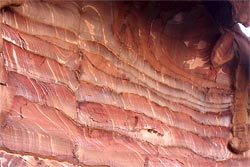
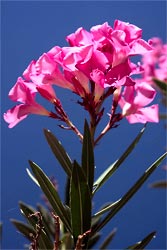 Monday mornings are always a bit difficult, but it seemed that an inordinate number of people were suffering from PPS on July 14. That's Post-Petra-Syndrome. There were extra-long choruses of yawns and groans on the morning buses, and some people even missed work at the dig.
Monday mornings are always a bit difficult, but it seemed that an inordinate number of people were suffering from PPS on July 14. That's Post-Petra-Syndrome. There were extra-long choruses of yawns and groans on the morning buses, and some people even missed work at the dig.
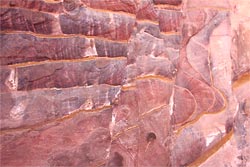 Welcome this week to the German zooarchaeological team comprised of Angela von den Driesch and Nadja Poellath. They are here to study the animal bones that have been unearthed over the course of `Umayri excavations. This week they reported a wild boar's tooth that had been perforated. That means it had been "culturally altered" and may have adorned someone's neck.
Welcome this week to the German zooarchaeological team comprised of Angela von den Driesch and Nadja Poellath. They are here to study the animal bones that have been unearthed over the course of `Umayri excavations. This week they reported a wild boar's tooth that had been perforated. That means it had been "culturally altered" and may have adorned someone's neck.
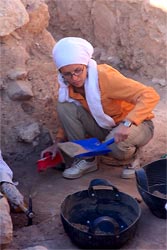 Welcome also to veteran Janelle Worthington, who comes to us from Bethlehem where she has been working in a Palestinian refugee camp.
Welcome also to veteran Janelle Worthington, who comes to us from Bethlehem where she has been working in a Palestinian refugee camp.
On Monday evening, we were to have a guest lecture from Michele Daviau, Director of the Wadi ath-Thammad Project, but she had to cancel because of illness. Ellen Bedell, a veteran of the dig, stepped into the breach and presented a workshop on top plans and Larry Herr talked about locus sheets. Top plans are two-dimensional representations of the areas being worked (loci) in each square. Besides the actual digging, there is a lot of paperwork that accompanies each day's work (earth locus sheets, architectural locus sheets, top plans, etc.) and though it can be complex, people like Ellen make it look simple.
Tuesday evening's Town Hall was on the Bronze Ages in the Madaba Plains in the context of Egyptian rule; the presenter was Kent Bramlett, with a feature from Lindsey Hill. Thursday's Town Hall was on the Early Iron Age in the Madaba Plains and Egyptian influences; presenters were Bob Bates, Monique Vincent, and Steven Salcido.
Wednesday's movie was National Treasure II.
Field M, at the top of the tell, experienced a "sift shift" this week. Although the sifts are routinely dug out several times during each dig day, the debris from sifting reaches a point where it can no longer be sufficiently cleared and that means the whole apparatus has to be moved. The re-bar anchoring the ropes helping to stabilize the sift poles have to be dug out. This can prove challenging, but as Jennifer Ayles can attest, perseverance pays off. Sometimes the re-bar removal technique can be a little unconventional, but the important thing is that the job gets done. Sometimes all it takes is a woman's touch!
The cook and kitchen staff at ATC work hard to provide meals that we can enjoy; this week proved no exception. We were treated to baked potatoes and chicken one day, and there was also a pistachio and coconut- festooned bread pudding.
In the whatever works department - On the way to breakfast one morning Denise Herr told me that she had brushed her hair with a nail brush. When one cannot locate the right "tool," one uses whatever one can find that may work. Groping around in the dark before lights come on at 4:15 a.m. can produce some humorous results as well, and it is always a good idea to check oneself in the mirror before going "public."
Because I work in Field M at the top of the tell, I am most acquainted with the antics in that area. Jimmy Arsenault usually keeps us entertained with his banter, but sometimes square supervisor, Lloyd Willis, gets in on the act. He has a bounty of interesting stories and facts that are educational, but I was surprised one day to hear the BowWow song emanating from his square.
Ever since her dune-rolling escapade at Wadi Rum, Elinor Matthews has been challenging Darren Heslop to try it, and she finally talked him into it in the sift dunes at the tell. It was such a great show that Elinor captured it on video. This is not the only extracurricular activity performed on the sift dunes. They also make a nice soft bed as Jennifer Ayles and Lynne Fulton well know. Autumn Whiteway has the proof!
Did you know:
Jennifer Ayles, the youngest member of our team at 18, is actually a bonafide blacksmith. She used her Klein bucks (only Albertans will understand) to take a course and now she can add that accomplishment to her many talents.
Krista Watson won the women's barrel racing event at the Calgary Stampede when she was 16. She grew up on a ranch and preferred working with horses to other more "girlie" things. She later designed clothing for rodeo queens and went on to establish a career in bridal design which made her a world traveler. She also worked as a field geologist and this has brought her into archaeology. She has found a new niche!
If you need that morning cup of java to kick-start your day, you have to see Don Mook. Don is a veteran of the dig and is renowned for his story telling and entrepreneurial skills. He is always the first person at first breakfast and if you get there early enough you can get in on the latest story. I don't think Don is ever at a loss for words. He sells dig caps which are labeled in English and Arabic and are a must-have souvenir for each dig season. Don is also the "postage stamp guy." If you want to send a post card anywhere in the world, Don will tell you what you need and how much it will cost. (He also makes lists of people who want stamps and actually gets them!)
In the interesting requests department - Nadja Poellath's husband, who is an icthyologist (fish specialist) in Germany, has requested that Nadja return with a specific perch-type specimen for his research. It is known as a St. Peter's tilapia, or a St. Peter's fish, a Galilee cichlid (Sarotherodon galilaeus). Nadja will have to acquire it, preserve it, and transport it. The chemicals that she needed in order to preserve the fish were in a backpack that did not arrive in Jordan. After communicating with her husband, who is currently in the Congo, she was assured that she could obtain the chemicals from a pharmacy in Jordan. Her sleuthing has paid off, and she has located a source for the chemicals and a source for the fish specimen. Good luck, Nadja!
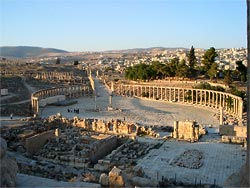 Weekends are always special because tours are on the menu. On Saturday July 19, we boarded A/C busses for a tour of two Roman sites which were part of the Decapolis, and a 12th century Ajlun castle. Julie Cormack was our tour guide and Carolyn Waldron was our hostess.
Weekends are always special because tours are on the menu. On Saturday July 19, we boarded A/C busses for a tour of two Roman sites which were part of the Decapolis, and a 12th century Ajlun castle. Julie Cormack was our tour guide and Carolyn Waldron was our hostess. 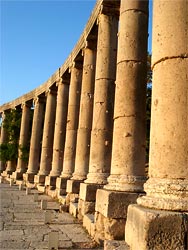 Jerash was the first stop. We entered at the impressive Hadrian's Gate which is undergoing reconstruction and walked past the Hippodrome where they stage authentic chariot races. On to the Oval Precinct and the Cardo (main street) where we could see Corinthian and Ionic columns still standing. The chariot tracks were still visible in the street cobbles.
Jerash was the first stop. We entered at the impressive Hadrian's Gate which is undergoing reconstruction and walked past the Hippodrome where they stage authentic chariot races. On to the Oval Precinct and the Cardo (main street) where we could see Corinthian and Ionic columns still standing. The chariot tracks were still visible in the street cobbles.
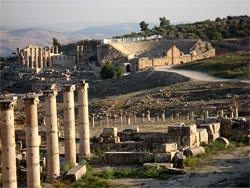 At the Nymphaeum, a typical public fountain, we heard stories of the bathing virgins and saw the remnants of the baths and fountains. Past the Temple of Artemis with a seeming thousand stairs, you could turn off the main street and find a mosque, or turn another direction and step into a Roman amphitheatre. (This particular amphitheatre was the venue for a Placido Domingo concert which was attended several days later by some of the dig team). You could spend a whole day here, but after two hours of exploration, we resumed our journey to the second site.
At the Nymphaeum, a typical public fountain, we heard stories of the bathing virgins and saw the remnants of the baths and fountains. Past the Temple of Artemis with a seeming thousand stairs, you could turn off the main street and find a mosque, or turn another direction and step into a Roman amphitheatre. (This particular amphitheatre was the venue for a Placido Domingo concert which was attended several days later by some of the dig team). You could spend a whole day here, but after two hours of exploration, we resumed our journey to the second site.
Umm Qays (Gadara) was our lunch stop. We ate the lunches we had packed plus watermelon; some of us were treated to prickly pear cactus fruit which we later discovered was not free! Fortunately, there was no gastro-intestinal price to be paid! Umm Qays is a unique Roman site in that it has basalt and limestone (black and white) constructions. Not only did we view the magnificent ruins, but from this site there was a clear view of the Sea of Galilee, the Jordan Valley, and the Golan Heights (which probably explains the presence of an armed tank near this site). For those of us who climbed to the restaurant, the view was breathtaking... and the cold drinks were refreshing. The bathroom here is also a real topic for conversation (I speak for the ladies' room only). Through an inner courtyard with grapevines and other greenery, you enter a room infused with natural light. There are trees and vines growing on the wall (which is open to the sky) behind the modern sinks. Many of us would love to have such a bathroom! The "leave no one behind" principle does not apply on our tours. Buses are instructed to leave at the appointed time, so it was with nail-biting closeness that Denise Herr and Dana Waters made it back to the bus, but they probably got to more sites than anyone else!
The third stop on our tour was Ajlun Castle, a castle built in 1184/85. As we neared the site, we could see the landscape changing; I had to take off my sunglasses to make sure I was not hallucinating. It was much greener here, with more trees and vegetation. We could see the castle high on a hill and see how formidable it must have been during battles such as the Battle of Hatin on July 4, 1187. (A snippet of history: Saladin fought against the Crusaders and beheaded Reynard Chantillon, but died of fever in 1194.) The castle had all kinds of staircases, and nooks and crannies. Some of the narrow slits in the stone walls were used for shooting arrows. In one "room" there was a collection of stone balls which were probably used in catapults. The climb to the top was challenging, especially since we had a limited time frame, but those who made it certainly enjoyed the view. There was even a little museum within the castle with artifacts of the time. It would have been easy to get lost here, but everyone made it safely back to the bus. At the foot of the castle was a man selling coffee and tea which he heated over a 45-gallon drum, but Rachelle Mutch opted for ice cream which she graciously shared with Talea Anderson (to make her headache go away!)
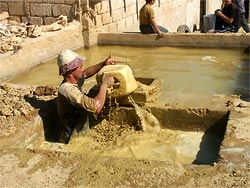 On Sunday, we were off on another tour to see the Zizzia potters and the mosaics of Madaba. This time we boarded our regular buses--no air-conditioning! This tour was hosted by Stefanie Elkins, one of our artists, and Gloria London, the ceramics specialist. The Zizzia potters came from Egypt to Jordan and still do everything using manual labor, except for the use of a small mill which churns out clay in the exact measurement for one pot. We saw how the clay was washed and worked by foot to remove impurities. Jenna Hurtubise was standing a little too close to the action, and received a rather wet and muddy souvenir of this process.
On Sunday, we were off on another tour to see the Zizzia potters and the mosaics of Madaba. This time we boarded our regular buses--no air-conditioning! This tour was hosted by Stefanie Elkins, one of our artists, and Gloria London, the ceramics specialist. The Zizzia potters came from Egypt to Jordan and still do everything using manual labor, except for the use of a small mill which churns out clay in the exact measurement for one pot. We saw how the clay was washed and worked by foot to remove impurities. Jenna Hurtubise was standing a little too close to the action, and received a rather wet and muddy souvenir of this process.
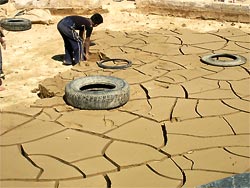
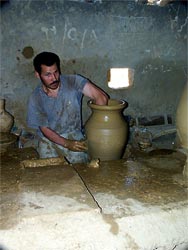 After settling in the water basins, the clay is placed in mounds where salt is added and it is then systematically stamped by pottery assistants. As the Zizzia assistants demonstrated, some of our people got in on the act: Megan Channer, Elinor Matthews, Jennifer Ayles, Teagen Johnson, and Jimmy Arsenault.
After settling in the water basins, the clay is placed in mounds where salt is added and it is then systematically stamped by pottery assistants. As the Zizzia assistants demonstrated, some of our people got in on the act: Megan Channer, Elinor Matthews, Jennifer Ayles, Teagen Johnson, and Jimmy Arsenault.
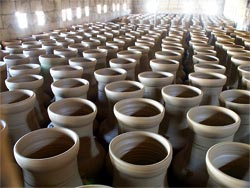 This was a barefoot (actually bare-legged up to the knee) activity, but somehow they all managed to get their feet and legs relatively clean before continuing the journey. The giant earth kilns that were outside were fired by refuse and could reach temperatures of 1400 degrees F.! Rob Saley was one of the brave few who got the view from the top and peered into the open kiln. Following the tour of pottery procedures, we were invited to select some small pots. Some people even bought ubreeks (water containers) and decorative vases to take home.
This was a barefoot (actually bare-legged up to the knee) activity, but somehow they all managed to get their feet and legs relatively clean before continuing the journey. The giant earth kilns that were outside were fired by refuse and could reach temperatures of 1400 degrees F.! Rob Saley was one of the brave few who got the view from the top and peered into the open kiln. Following the tour of pottery procedures, we were invited to select some small pots. Some people even bought ubreeks (water containers) and decorative vases to take home.
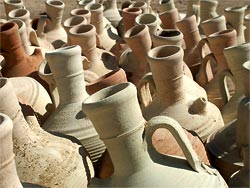 Our bus driver got a small ubreek , the use of which he tried to communicate to us through a series of sounds and charades. We think it was destined to keep goats' milk cold!
Our bus driver got a small ubreek , the use of which he tried to communicate to us through a series of sounds and charades. We think it was destined to keep goats' milk cold!
The second stop on this tour was St. George's Greek Orthodox Church with its famous mosaic floor map. We had an interesting time actually getting there since the buses drove round and round without reaching this destination. We probably saw more of Madaba this way, but we finally disembarked near the church with instructions to meet at the same place in about 3 hours. We viewed the mosaic, trying to make out the Greek names. Some, like Jerusalem and Jericho, were relatively easy to discern, but others were more difficult, except maybe for Rob Saley. In the crush around the map, we were rubbing shoulders with tourists from all over the world; the evidence was the cacophony of languages. The church interior was ornate, adorned with gold chandeliers and wall mosaics and icons. We met outside the church following the viewing and were led to a few small shops by "shopper extraordinaire," Stefanie Elkins; then we were set loose on the town. Heather Hartmann made a beautiful and practical purchase which she was invited to wear immediately. It was a light and lovely caftan which the shop owner assured her would be more comfortable than her regular clothing. Absolutely true! Dana Waters and others enjoyed seeing how a mosaic was put together in the Philadelphia Mosaic Works. Mosaics are definitely labor-intensive, but we gained a perspective into this age-old art which we had viewed at St George's and previously at the Petra Church. Some of the weary and not-so weary shoppers made their way to Haret Jdoudna, a restaurant with an inner courtyard, where they sampled delicious offerings of bread, soups, vegetables, and other interesting and different entrees. Gary and Suha Huffaker were seated comfortably with a group at a table near a tree. Most of our tour group made their way to this delightful restaurant and enjoyed the variety of Jordanian food that was available. Besides this courtyard, there was another interior courtyard with sofa-like lounging areas and hookahs (water smoking pots) for serious diners, probably the evening crowd. With water and cold drinks in hand, we made our way to the buses and arrived back at ATC without incident.
When we got back from our tour, it was a few hours before supper and we expected the usual Sunday evening mountain of laundry to sort through, but we were pleasantly surprised to find that the laundry-sorting fairies had been there and had sorted out sheets, pants, T-shirts, etc. Head laundry fairy was Annelise Weiss and her helpers were Brenda Adams and Danielle Huffaker. Bless you, laundry fairies!
[ Photos courtesy Douglas R. Clark and MPP-`Umayri ]